Salesforce Development Lifecycle and Deployment Architect Exam Guide
1. About the Salesforce Development Lifecycle and Deployment Architect Exam
The Salesforce Development Lifecycle and Deployment Architect credential is designed for those who assess their architecture environment and requirements and then implement management solutions on the Salesforce Platform that meet those requirements.
- Content: 60 multiple-choice/multiple-select questions and 5 non-scored questions
- Time allotted to complete the exam: 105 minutes
- Passing score: 65% (39 out of 60 Questions)
- Registration fee: USD 400 plus applicable taxes as required per local law
- Retake fee: USD 200 plus applicable taxes as required per local law
- Prerequisites: None
2. Exam Outline
Application Lifecycle Management: 8%
- Given the project risk and customer requirements, explain how to assess the benefits and risks of the different development methodologies and recommend the appropriate governance strategies based on the customer maturity.
Planning: 13%
- Given a complex customer scenario, assess Application Lifecycle Management maturity and identify the people, technology, and processes required.
- Understand customer environment risks and articulate appropriate mitigation strategies.
- Given a customer scenario, analyze and recommend the appropriate governance framework.
- Given a customer scenario involving a new Salesforce release (Summer, Winter, Spring), recommend the appropriate strategy to mitigate risks.
System Design: 15%
- Explain the advantages of using agile tools to support an agile development process.
- Given a customer landscape and their requirements, evaluate business, technical and architectural considerations which support the defined org strategy.
- Given a customer scenario, define an environment (sandbox) strategy that utilizes the correct sandbox types. (e.g. multiple project streams, training requirements, staging, production, and hotfixes)
- Given a scenario, compare, contrast and recommend the components and tools of a successful deployment strategy.
Building: 14%
- Given a customer scenario, explain how source control branching/versioning/merging can be used and recommend appropriate strategies.
- Describe the appropriate approaches to building test data strategy and unit test to ensure successful code (positive, negative, permission-based, large data volume).
- Given a customer scenario, describe the appropriate development model (org-based vs package-based) and development environment (scratch org vs sandboxes).
- Describe the methods to ensure the delivery of quality code, such as coding standards, pull requests, code review, and static code analysis
Deploying: 14%
- Given a scenario, describe the capabilities, limitations and considerations when using the Metadata and Tooling APIs for deployment.
- Given a scenario, describe approaches to handle pre and post deployment steps, including items not supported via the APIs.
- Given a scenario, describe approaches to manage and deploy technical reference data.
Testing: 13%
- Given a customer scenario, describe and recommend an appropriate testing methodology.
- Given a customer testing strategy, describe the appropriate test execution methodology and coverage requirements.
- Given a customer scenario, describe and recommend a unified test data strategy that utilizes representative data in a secure manner throughout the development lifecycle
Releasing: 13%
- Given a scenario, analyze and explain the use cases and considerations when using managed, unmanaged and unlocked packages.
- Apply map sandbox strategy to a specific Release Plan taking into consideration multiple project streams, training requirements, staging and hotfixes.
- Given a customer scenario, describe and recommend an appropriate release management strategy.
Operating: 10%
- Given a detailed customer environment scenario including a specific request, explain the implications for incorporating the request directly in a production environment.
- Given a customer scenario where changes are made directly in production, explain the implications on the development lifecycle and steps to integrate changes into Application Lifecycle Management.
- Given a multi-org customer scenario, compare and contrast approaches for managing common release artifacts


